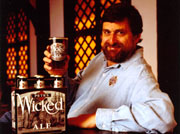Hurdles and Strategic Partnerships
Pete admits that he and Mark didn’t know what they were doing all the time and that they made mistakes. The venture almost came to an untimely end. On a Wednesday night while Pete was brewing his second batch of beer, he received a call from the owner of Palo Alto Brewing. “The owner told me that he was going Chapter 7 on the upcoming Monday. He suggested to me that I get as many friends as possible into the brewery to get my beer out of there before they lock the door on Monday.” Pete gathered about 15 friends to work for 2.5 days, 24 hours a day to get the beer out. Pete was able to immediately sell that beer, and then worked to secure a new brewing facility. When contacting brewers on the West coast, they received responses that ranged from “we’re at capacity” to “we don’t want to because we view you as a competitor”. They looked outside of the area, and traveled to the Twin Cities in Minnesota. They stayed with Mark’s mother, and rented a car to search Wisconsin and Minnesota . They found a great brewery that fulfilled their brewing needs – August Schell Brewing.
Pete’s Brewing has maintained strategic these alliances with other brewing companies to create their product, without the responsibility of owning and maintaining the capital equipment. Pete’s uses the equipment of the Stroh Brewing Company. Pete’s has its own two brewmasters, and several operations people living at the brewery in St. Paul, Minnesota “When it’s our turn to brew, we’re in charge.”
Pete also discussed the challenges he faced selecting a person for the full time role of President of the company. “It wasn’t easy. The first guy we hired didn’t work out. Number two was found with a headhunter . This guy from Coors arrived and left as quickly as he got there.” The headhunter then went out and found Mark Bossini who came in as President and CEO who brought extensive experience with his career at the Seagram Beverage Company and has only recently retired from Pete’s Brewing.
The Future of Pete and Pete’s Brewing
The success and growth of Pete’s Brewing continues to this day. Thousands of bottles, cases, and barrels have been sold in restaurants, on airplanes, and other retail outlets. A successful initial public offering of Pete’s Brewing in November, 1995 raised $42MM. For three consecutive years, Pete’s Brewing was named to Inc. magazine’s “Top 500 Fastest Growing Companies in the United States.”
The Pete’s product line has grown to eight everyday brews, including the Wicked Maple Porter, the Wicked Strawberry Blonde, and the Wicked Honey Wheat. Pete’s also produces four seasonal beers such as the Wicked Mardi Gras and the Wicked Winter Brew.
What does Pete attribute the success of his organization to? “Beer is very much a sensory experience. It is a combination of color, taste and aroma.” Pete explains that other beers try to emphasize only one of these characteristics, while Pete’s tries to capture all of them from the malt/grain, and hops. As for the success of the organization, “We’ve had great people busting their buns. Also, back to the strategy that we’ve maintained since 1985, if you have a great beer, great label and great name, and focus on distribution support for your wholesalers and retailers, and have fun doing it, there is no limit.” – ###


